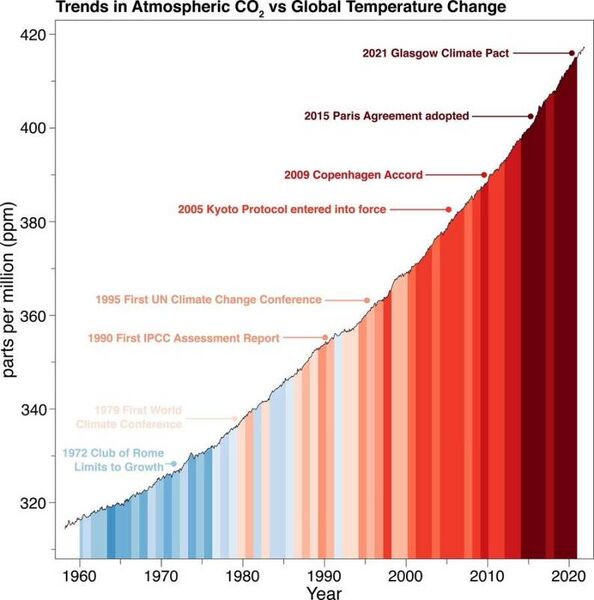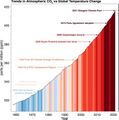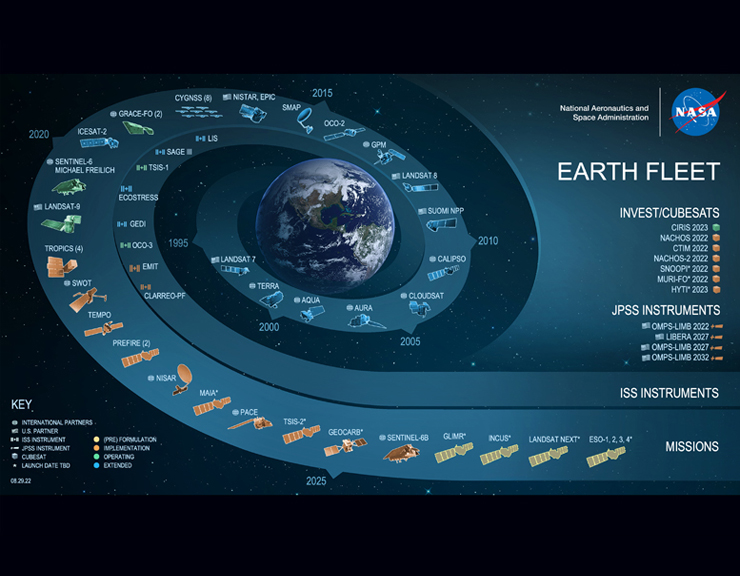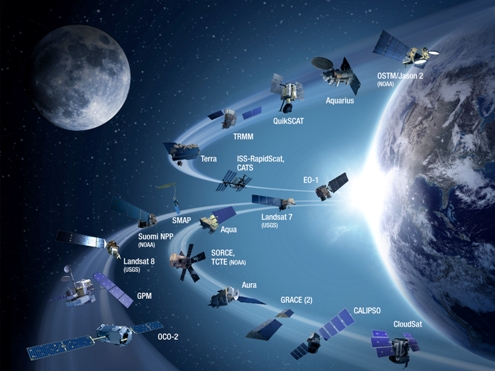File:Global climate conferences and GHG increases.jpg

Original file (793 × 801 pixels, file size: 56 KB, MIME type: image/jpeg)
A History of Climate Activities
Via the World Meteorological Organization
Origin of the climate issue
While climatology has always been recognized as an important branch of the science and practice of meteorology (Landsberg, 1945) and the basic physics of greenhouse warming has been understood for more than a century (Houghton, 2009), the present global concern with climate issues really dates from the convergence of five important scientific, technological and geopolitical developments... which shaped the transition of climatology from a descriptive to a physical science.
Post-World War II advances in basic atmospheric science that led to greatly increased understanding of the mechanisms of the large-scale circulation of the atmosphere;
Initiation of a number of new geophysical observations (especially the Mauna Loa measurements of atmospheric carbon dioxide) during the 1957 International Geophysical Year;
Recognition of the potential meteorological observing capabilities of Earth-orbiting satellites;
The advent of digital computers (GreenPolicy360: and digital databases linked to satellite earth imaging with digital multispectral scanning cameras); and
The willingness of countries, even in the developing Cold War environment, to use the institutions of the United Nations System for cooperation in addressing important global problems.
The World Climate Conferences
Via Wikipedia
1979 (GreenPolicy360: One year after the first U.S. National Climate Program Act setting forth a legislative 'comprehensive and coordinated national climate policy' actions with a series of earth/atmospheric science missions)
The First World Climate Conference was held on 12–23 February 1979 in Geneva and sponsored by the WMO.[1] It was one of the first major international meetings on climate change. Essentially a scientific conference, it was attended by scientists from a wide range of disciplines. In addition to the main plenary sessions, the conference organized four working groups to look into climate data, the identification of climate topics, integrated impact studies, and research on climate variability and change. The Conference led to the establishment of the World Climate Programme and the World Climate Research Programme. It also led to the creation of the Intergovernmental Panel on Climate Change (IPCC) by WMO and UNEP in 1988.
🌎
Climate Problems, Climate Solutions
🌎
Bookmark Climate Policy @GreenPolicy360
🌎
"Earth Observing System": Decades of Earth Science/Climate Science Data Accessible for Planet Citizen Action
🌎
File history
Click on a date/time to view the file as it appeared at that time.
| Date/Time | Thumbnail | Dimensions | User | Comment | |
|---|---|---|---|---|---|
| current | 21:16, 11 November 2022 |  | 793 × 801 (56 KB) | Siterunner (talk | contribs) |
You cannot overwrite this file.
File usage
The following 2 pages use this file:
- About Us
- Air Quality
- Air Pollution
- Agriculture
- Alternative Agriculture
- Antarctica
- Anthropocene
- Arctic
- Atmospheric Science
- California
- Citizen Science
- City Governments
- Clean Air
- Clean Water
- Climate Change
- Climate Migration
- Climate Policy
- Countries
- County Governments
- Democracy
- Desertification
- Digital Citizen
- Earth Imaging
- Earth Observations
- Earth360
- Earth Science
- Earth Science from Space
- Earth System Science
- Ecology Studies
- Eco-nomics
- Economic Justice
- Education
- Energy
- Environmental Full-cost Accounting
- Environmental Laws
- Environmental Protection
- Environmental Security
- Environmental Security, National Security
- ESA
- European Union
- Externalities
- Extinction
- Fisheries
- Florida
- Food
- Forests
- Fossil Fuels
- Germany
- Greenland
- Global Security
- Global Warming
- Green Best Practices
- Green Graphics
- Green Networking
- Green Politics
- Health
- INDC
- Maps
- Media
- Money in Politics
- NASA
- NOAA
- Natural Resources
- Networking
- New Definitions of National Security
- New Economy
- New Space
- Oceans
- Ocean Science
- Online Education
- Planet Citizen
- Planet Citizens
- Planet Citizens, Planet Scientists
- Pollution
- Rainforest
- Renewable Energy
- Resilience
- Russian Federation
- Sea-level Rise
- Sea-Level Rise & Mitigation
- Seventh Generation Sustainability
- Social Justice
- Soil
- Solar Energy
- Strategic Demands
- Sustainability Policies
- Threat Multiplier
- Transportation
- Ukraine
- United Nations
- US
- US Environmental Protection Agency
- Water
- Water Quality
- Water Saving
- Whole Earth
- Wind Energy
- World Bank
- World Wide Web
- Youth

